Chapter: Aquaculture Engineering : Ammonia Removal
Construction of nitrification filters
Construction of nitrification filters
The main purpose when constructing a nitrification filter is to create a surface for optimal growth of the biofilm. Depending on the construction and the filter medium on which the biofilm is established, it is possible to distinguish four types of biological filter:
· Flow-through system
· Bioreactor
· Fluid bed/active sludge
· Granular filters/bead filters.
Flow-through system
The flow-through system may again be divided into three types depending on how the water flows through the filter medium (Fig. 9.2):
· Trickling filter
· Submerged up-flowing system
· Submerged down-flowing system.
In a trickling filter, the water trickles through the filter medium where the biofilm is established. The filter medium is located above the surface of the water and it is very similar to a column aerator. Advantages of this filter type are its simple construction, that good natural aeration for the process is achieved and that it is impossible to block. The
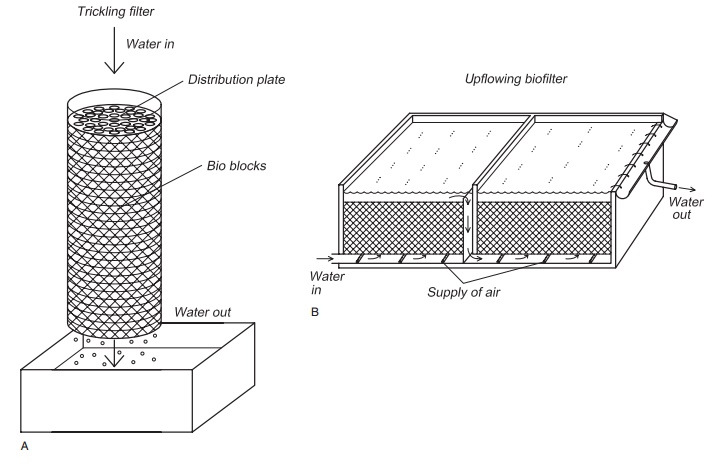
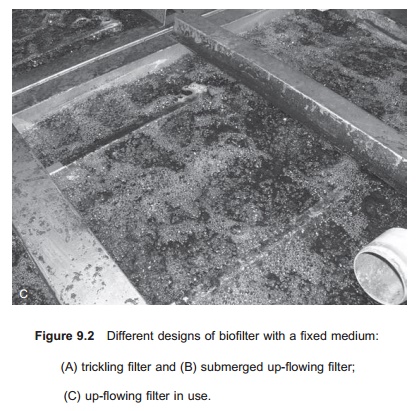
In an up-flowing filter the water is supplied under the filter medium, which is submerged. The incoming water is forced through the filter medium by the flow and head of the water. There are several advantages with this system: it provides good medium structure, good distribution of the water in the total medium volume is possible, and there is good contact between the water and the filter medium where the biofilm grows. The disadvantage is that it is necessary to add oxygen or air with positive pressure, for example by using an air blower, below the filter medium to ensure that the bacteria in the biofilm get enough oxygen.
A down-flowing filter uses a similar technique to an up-flowing filter; here also the filter medium is submerged. The water is supplied at the top of the filter and is distributed through it. There is a ‘water lock’ at the bottom of the filter and this ensures the filter medium is always submerged. An advantage with this filter type is that the water flows in the opposite direction to the air bubbles, so quite good mixing of the air/oxygen and water is achieved. The disadvantage is the same as that for the down-flowing filter: it is necessary to supply oxygen or air; however, in addition, it is difficult to obtain the same good distribution of water in the total volume of the filter medium as in an up-flowing filter.
The filter medium in the biofilter
It is important that the surface of the filter material on which the biofilm grows is optimal. In fish farming where the ammonia concentration and concentration of organic matter are low compared to levels in municipal wastewater, it is most effective to use systems where a biofilm is established on an artificial surface. The following requirements must be met by the filter medium:
· Have large specific surface areas where biofilm can be established (surface area per unit volume, m2/m3)
· Ensure proper contact between the water and the surface of the medium
· Create low head loss
· Be difficult to clog
· Ensure an even distribution of water in the entire filter medium
· Be simple to clean.
In practical farming conditions it is difficult to fulfill all these requirements. There is a conflict between having a nitrification rate as high as possible and the need for a simply operated and maintained system.
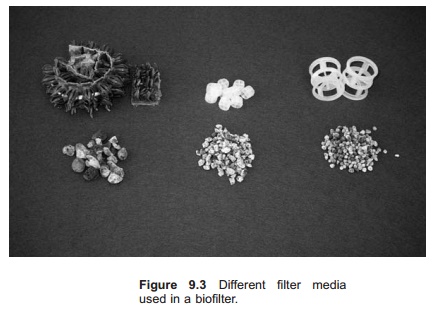
In the past gravel and sand were much used as filter media in biological filters. Today different types of plastic filter media have replaced sand and gravel in many applications34 (Fig. 9.3). This is because they have a have large specific surface areas where biofilm can be established, and they are not so easily clogged. Leca (lightweight clay aggregate) is a material with very large specific surface are that has been used to create surface for biofilm with good results.35 However, there are problems with clogging when the grain size is small and water flow large.
Rotating biofilter (biodrum)
A rotating biofilter, also known as a biodrum or rotating biological contactor (RBC), utilizes the same basic principle as the submerged filter (Fig. 9.4). The filter medium where the biofilm is established rotates at 2–3 rpm, partially above the water surface and partly submerged. The oxygen necessary for nitrification is supplied when the medium is above the water surface. Two different designs of rotating biofilter are used: (1) a cylinder filled with biobodies (filter medium in small elements); (2) parallel discs made of plates where the biofilm grows on the surfaces. In both cases the biofilter is mounted on a rotating shaft.
The advantage of this type of filter is that as a result of the rotation aeration occurs when the filter medium is above the water surface, so nitrification can occur. In such systems the efficiency is quite low and it may be necessary to add extra air/oxygen to the tank where the drum is rotating.
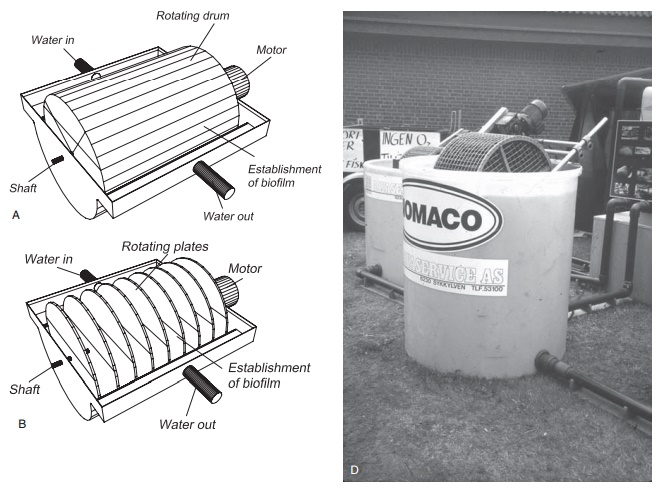
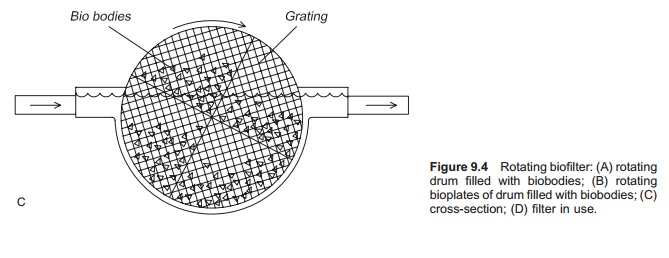
Fluid bed/active sludge
In an active sludge reactor the bacteria are attached to suspended sludge material and kept floating in the water column. The nitrification process occurs on the surface of the suspended solids. Because of the relatively low content of ammonia, suspended solids and organic substances, this is not an appropriate method for use in aquaculture. The method is, however, widely used for treatment of municipal wastewater.
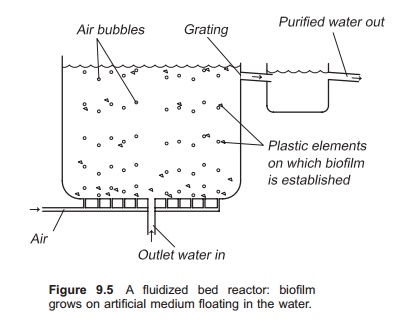
A fairly new method is to utilize a so called fluidized bed reactor, which has much in common with the active sludge method (Fig. 9.5). Here an artificial filter medium, normally plastic, floats in an up-flowing current of water and air bubbles (supplied by diffusers at the bottom). The medium is maintained in suspension by the current, like a fountain. Specially designed filter medium is used for this purpose, with a density slightly below that of water, so it is quite easy to keep fluidized. In addition, the medium is in small elements, so has a large specific surface area and will float in rotating movements in the up-flowing water. A filter grating is necessary on the outlet to prevent the elements fol-lowing the water out of the reactor.
Biological nitrification takes place on the surface of the elements where the biofilm is established. It is very important to supply enough oxygen/air in this system to provide optimal growth conditions for the biofilm on the elements. Correct construction of the reactor where the elements are floating is important if high nitrification rates are to be achieved. One advantage with this system is that it is difficult to clog. A quite stable water flow is, however, important to obtain optimum functioning. The efficiency of such filters is also quite good because old biofilm is constantly removed by the air bubbles, the water flow and the rotation of the elements, which all erode to the biofilm. Only new thin fresh biofilm is therefore established on the filter medium elements. Thin new biofilm has been shown to have the highest nitrification rate. The nitrification process is reduced in thick film because it is difficult to get enough oxygen and nutrients to the deeper layers. Plastic media have been shown to produce good results in several water re-use plants.
Granular filters/bead filters
A granular filter used for removal of ammonia is the same as that used for particle removal. Hence two operations can be carried out by one filter. This type of filter will, however, require frequent back-washing to remove particles.
A bead filter is a type of granular filter, which is commonly filled with spherical plastic pellets (poly-ethylene (PE)/or polypropylene (PP)) with slightly positive buoyancy. The water flows upwards through the layer of plastic pellets and biofilm is created on the pellet surface. Back-washing of the filter medium to avoid blockage can be performed with air bubbles, circulating water or mechanically by paddles or propellers. Experiments have shown reduced nitrification rates in such filters compared to other flow-through systems, even if on a per volume basis they are quite effective as a result of their the large surface area.
Traditional up-flowing sand filters may also be used as biofilters, but the nitrification rate is low and requirements for maintenance and back-washing are high.
Related Topics